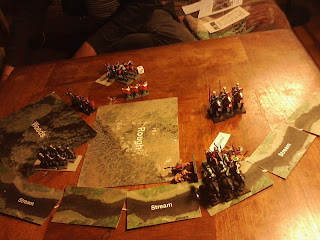A ship that is orbiting a planet has a speed of zero. However, the ship automatically moves one hex around the planet each turn. The direction of the orbit (clockwise or counterclockwise) is up to the player who controls the ship. [SFKH Tactical Operations Manual, p. 4]
In reality, objects are not limited to orbiting a planet from only 10K km away; in fact, it could be from any distance within the planet's Hill Sphere (e.g., 1.5 million km for our own). Furthermore, orbital velocity is determined by a rather simple calculation based on a gravitational constant, mass of the planet, and orbital radius: v = √(G×M/R), and for an Earth-sized planet (as portrayed on the boardgame counters), the 1-hex/turn speed is not actually correct. The proper velocity would be a bit less than half that (decreasing the further away you get), and so one of my top house rules is to adjust the standard orbital speed to ½-hex per turn (see here).
Now, the reason for doing this is not just empty realism, although if no other gameplay problems arise, then I do think there is a benefit to attempting the "highest degree of realism" (see golden rule). Nor is the point simply an educational exercise, although I think there is a benefit to that, too. The real gameplay payoff is that this sets the stage for a variety of different orbital action at different distances and planetary masses. See the following graphic for some examples of real orbital possibilities (and get the open document spreadsheet here):
Here's some analysis for Earth-size planets (basically like all of the populated worlds in the Star Frontiers universe):
- No such planet can support any orbit of 1-hex/turn; the necessary orbit would be literally deep inside the planet itself.
- Low Earth Orbit, where most of our real-world satellites, space stations, and manned spaceflight have gone, is a bit less than a full hex from the planet's center, at a velocity of a little under ½-hex per turn, and circles the globe in 12 turns (2 hours).
- Middle Earth Orbit, such as 2 hexes distance, would be at a speed of about 1/3 hex per turn, completing the orbit on the hexmap in 36 turns (6 hours).
- Semisynchronous Orbit (SSO), matching that of all GPS satellites, would be about 3 hexes from the planet, with a speed of 1/4 hex per turn, going around every 72 turns (half a day).
- Geosynchronous Orbit (GSO) would be 4 hexes away, at a speed of 1/6 hex per turn, making a cycle every 144 turns (one day).
- High Earth Orbit would be anything further away than 4 hexes; for example, our own Moon would be positioned about 40 hexes away, traveling at an orbital speed of 1/16 hex per turn (completing a cycle in about a month's time, of course).
- Neptune-like planets would in fact support a 1-hex/turn orbital velocity at the closest possible position, 3 or 4 hexes from the center of the planet. A middle orbit distance of 5 or more hexes away would be at ½-hex per turn speed.
- Saturn-sized planets would have the closest possible orbit at 7 hexes from the planet's core, also at a speed of about 1-hex per turn. In fact, the same would be true for any orbit established between 7 and 25 hexes away. Further away than that, and a speed closer to ½-hex per turn would be more appropriate.
- Jupiter-style planets with their powerful gravitational field would allow a faster orbital velocity of over 2 hexes per turn at anything from 8-20 hexes from the planet's core. Further away than that (anywhere on the standard hex map), and a speed of 1-hex per turn is still attainable.
So consider adding a wider array of planetary locations and gravity effects to you Knight Hawks games; variety is the spice of life, and if you can broaden your players' minds, so much the better. Below I've included images of some gas-giant planets that you can print (at 72 pixels per inch) and use in your game for this purpose. (Neptune is about 5 hexes in diameter, Saturn is about 12, Jupiter 15.) Finally, I've got reference links at the bottom if you want to read more on the issue of real-life orbital variations.
Reference links:
- http://upload.wikimedia.org/wikipedia/commons/8/82/Orbitalaltitudes.jpg
- http://en.wikipedia.org/wiki/Orbital_speed
- http://www.calctool.org/CALC/phys/astronomy/earth_orbit

































